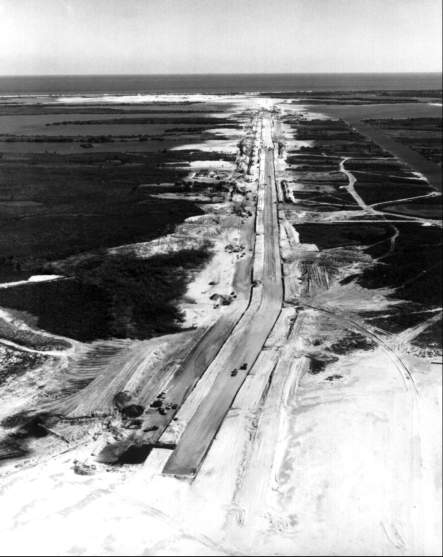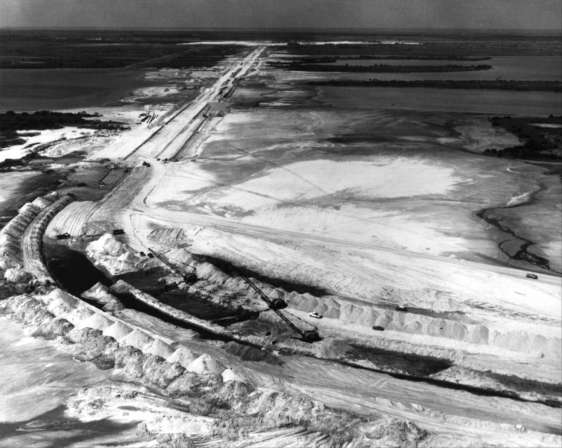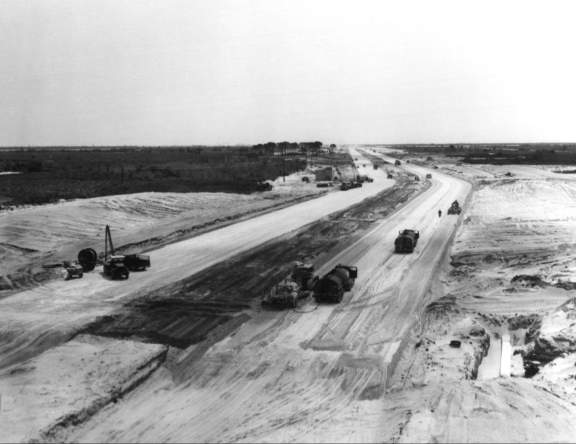
Building a New Kind of Road
For the safe movement of the crawler-transporter, mobile launcher, Saturn V, and Apollo (a load exceeding 8,400 metric tons), engineers would have to design a unique roadbed. The completed crawlerway would look something like the many interstate highways under construction throughout the nation in the 1960s. Beyond surface appearance, however, the resemblance ended. The crawlerway would support loads never envisioned for a public road-loads in excess of 58,000 kilograms per square meter.16
Gahagan Dredging Company had already begun preliminary site preparation. After excavating softer, unsuitable surface material, Gahagan had pumped nearly 2.3 million cubic meters of hydraulic sand fill into place on the crawlerway route. Vibratory rollers had compacted this fill under the trackways, and then a 90,600 kilogram vehicle proof-rolled them.
Each of the dual trackways, separated by a median strip, would consist of slightly over a meter of selected sub-base material, topped by a meter of graded crushed aggregate, with a blacktop sealer over all. A service road would border the south side of the crawlerway from the VAB to pad A. Underground ducts for communication and instrumentation lines to link the control and assembly areas with the launch pads would parallel the north side of the crawlerway; power line ducts and a pipeline for drinking water would go along the south side. Where any of the ducts or pipes had to pass beneath the crawlerway, the access tunnels had to be capable of withstanding the load conditions. The completed crawlerway would be level with the terrain, 2.3 meters above sea level.

Crawlerway under construction. (1) The terrain was not the best for supporting heavy vehicles (February 1964).

Crawlerway under construction. (2) The site of the assembly building is top, center; pad A is off to the right (April 1964).

Crawlerway under construction. (3) The communication and instrumentation duct is open in the right foreground (July 1964).
Two firms, the Blount Brothers Construction Company of Montgomery, Alabama, and the M. M. Sundt Construction Company of Tucson, Arizona, acting jointly, agreed to build pad A and the crawlerway for $19,138,000, somewhat under the estimated cost of $20,000,000. Blount-Sundt started work on 19 November 1963. The contract called for the construction of about 5,500 meters of crawlerway from the VAB to launch pad A, the elevated pad, several related facilities in the pad area, and the parking site for the tower. Subsequently a high-pressure-gases converter-compressor facility was added to the contract, at a cost of $155,000. The converter-compressor facility was to be complete on 1 May 1964, the arming tower (mobile service structure) parking site by mid-May, the crawlerway ready for test by 1 November, and the overall project by 1 June of the following year. The George A. Fuller Company of Los Angeles signed a contract on 30 November 1964 to construct pad B and extend the crawlerway 2,100 meters. Using experience gained by Blount-Sundt, the Fuller personnel were well on their way with their work by the middle of 1965.17
The converter-compressor facility was built just north of the crawlerway, about one-third of the distance from the VAB to pad A. It consisted of a one-story equipment building and a 1,892,000-liter spherical tank for storing liquid nitrogen, together with an access road and paved parking areas. A railroad spur brought tank-car loads of helium and nitrogen to the facility. Its evaporators, compressors, and pumps, in turn, supplied high-pressure gaseous nitrogen and helium to storage and distribution facilities at the VAB and the launch area.
Since plans called for the construction of the mobile service structure on the parking site, this facility would have to support considerable loads. The service structure would weigh 4,763 metric tons. When the crawler- transporter moved beneath it, the total load on the parking position would be nearly 7,500 metric tons, heavier than the USS Halsey, a guided missile frigate. In addition to this, calculations showed that, should wind velocities reach 200 kilometers per hour, the service structure, standing by itself on its four support legs in the parked position, with side struts and hold-down arms for each leg, could exert about 6,300 metric tons of force. To withstand these anticipated forces, the parking site had to have a heavily reinforced base.
| Next |